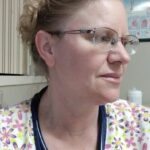Summary
When is it okay to admit that you don’t know how to do something? Hear the story of Tamara Kuhn, a bedside telemetry nurse, who in a moment of crisis, used her problem-solving skills to keep her patient (and herself) safe. Tamara was caring for a patient who suddenly became violent. After calling for help, Tamara was given what she thought would be a standard restraint system. But what she received was not equipment she was used to. So how do you set yourself up for success in these situations? Connie spoke with Jill Clemmons, an acute care nurse practitioner, for insight. Jill discusses how taking care of yourself, preparation, and finding your why are key to navigating difficult situations.
Episode Guests

Tamara Kuhn
Tamara Kuhn is a bedside telemetry nurse in California.

Jill Clemmons
Jill Clemmons is an acute care nurse practitioner and teaches critical care at the University of Kentucky.
Transcript
DDx SEASON 8 | They Don’t Teach That in Nursing School, EPISODE 3
Critical Learning on the Job
Tamara: I was taking care of a patient who came up from the emergency room and I’m a new employee, and he was detoxing from drug and alcohol abuse. And very quickly, out of the blue, became extremely violent.
And I called for some help, and they ran and got me what I thought was going to be a restraint system. And I opened the bag and thought, what is this? I have never seen restraint systems that look like this. There was all sorts of extra cords and I had no idea what this bag of stuff was. But I needed to restrain the patient quickly because he was going to hurt himself. And it was very scary.
Connie: That’s bedside telemetry nurse, Tamara Kuhn.
Tamara’s been in this game a long time and knows how to handle herself during a crisis.
But that’s not something that comes naturally to everyone.
In this profession you’re pretty much constantly asked to learn critical skills on the job in circumstances where the stakes couldn’t be higher.
So how do you set yourself up for success in that kind of situation?
Tamara: When you’re in a situation where you’ve got a new piece of equipment or something’s happening that you’re not familiar with, you really do have to take a breath because it is very terrifying and your immediate reaction, your fight and flight, will send you into a spiral of lack of control and you will make a mistake if you allow yourself to get out of control like that.
Connie: This is They Don’t Teach That in Nursing School, a podcast from Figure 1 about how nurses think.
I’m Connie Levie.
After 16 years at my hospital in the nuclear medicine department, I was ready for a change. COVID had just hit and I saw my nurse friends struggling. I decided to go to nursing school, so I could help out.
After years in medicine, I’ve learned that the most essential lessons are those that you learn on the job.
And that’s exactly what this show is about.
This is a show where we provide unique practical solutions to some of the most challenging problems nurses face.
From learning how to operate a ventilator during the height of COVID to dealing with an attending physician who’s a bully.
We’ll be sharing the secrets of the trade from nurses, doctors, medical researchers – the professionals you wish you could consult, but rarely have the time or opportunity.
You’ll feel seen, gain wisdom, and be better equipped to respond to all the unpredictable stuff that gets thrown at you.
Today’s case is all about how to learn critical skills on the fly and comes to us from bedside telemetry nurse, Tamara Khun in California.
So let’s return to our opening story.
Tamara needed to restrain a violent patient, but the restraints she was given were completely unrecognizable to her.
She needed to be calm and focused so she could quickly react and learn a critical skill before things got out of control.
Here’s how she got there.
Tamara: You have to take a breath and remind yourself that you are a professionally trained, licensed professional. You know what’s going on. Just because what you’re looking at is outside of what your past experience is doesn’t mean that you don’t know what to do with a human body. You know how to take care of them and just talk yourself through, wait, I can do this. Just remind yourself, you’ve been trained for this. Just because you don’t know this one piece of equipment doesn’t mean you’re not trained to take care of this patient.
Connie: A big part of this is your self-talk — the story you tell yourself — which contributes to your overall confidence.
We’ll dive into that in more detail later.
Tamara: There’s a saying, fake it till you make it, and that’s taken within the context of my knowledge. I can’t get on an airplane and drive an airplane and fake it, but I can within nursing because I have that baseline knowledge and I have that understanding of human physiology. So I can go into a room with confidence, even though I don’t know the machines, I can look at them, I can pretty well understand what they’re doing.
Connie: Tamara quickly used the part of the restraints that she recognized — those for hands and ankles — and put them on the patient.
But she still had this box full of cords that she didn’t know what to do with.
Tamara: So I put on what I could. I took note of the brand name on the box, ran over to the computer, and Googled the company.
And within a second or two, a picture pops up of the patient in all of the restraints. And I suddenly realized, oh, that tangle of cords was the chest restraint. And that tangle of cords was the waist restraint. And I could see very quickly from the picture how to put them on. Was it ideal? Did I do it 100 percent right?
Probably not. But I was able to quickly run back to the patient room, get him in the rest of the restraints, and make him safe so that I could then call for more help and for professionals.
I had no idea I was going to have to Google how to use restraints, because I’ve used restraints a lot and I know how to do them. But, it was a new system, and I had to figure it out quickly.
Connie: Tamara solved this problem quickly, so let’s raise the stakes.
Let’s go back to the winter of 2020.
It’s the early days of COVID.
There’s no vaccine.
People are dying.
Hospitals are overrun.
And we really don’t know how all of this is going to end, let alone how we’re going to get through it.
During this time Tamara left her clinic and returned to the small town where she grew up to work in the local hospital.
Tamara: So I got thrown onto the COVID floor with no support, by myself, and I wasn’t allowed to have contact with the other nurses. It’s a small hospital. They were very busy. We were short staffed by half. My ability to ask them for help was minimal to none. There was no supervisor, no manager, no educator. There was a doctor down in the ER and a doctor in the ICU, and so they weren’t available for help. And I found myself with equipment that I was completely unfamiliar with and didn’t even know existed.
Connie: The pressure sounds unbearable.
One of the machines Tamara was expected to use was similar to a ventilator but with crucial differences.
And she had zero support.
Yet — spoiler alert — Tarama not only got through it, but she did her job remarkably well.
Here’s how.
First, she did her homework.
She knew that when COVID hit, there was a chance she’d be called in from her clinic to work in acute care, and she wanted to be ready.
Tamara: If they called me into acute care from the clinics, that means they were in desperate need and were not going to have time to support me learning in a normal way that you would train somebody. So I really needed to educate myself on the off chance that I was asked to go in.
In the evenings when I was away from my work and that’s when I was researching and upgrading myself on ventilators, electrolyte balance, all kinds of things that aren’t in my realm of thought when I’m in a clinic setting.
Connie: Second, as we talked about earlier, Tamara was confident in her experience and training.
But even the most confident person can still get thrown off.
Tarama had studied ventilators, but when she was thrown into a situation where she had to operate life saving equipment — something similar to a ventilator but with big differences — she freaked.
Tamara: I had to talk myself down because my first reaction is, I’m not doing this, but that’s really not an option when you’ve got a pandemic, you’ve got a small town, very busy staff under by half, and really a situation where I couldn’t get support even if I wanted it.
Remember that you know your ABCs, your airway, breathing, circulation. You can do this. And it really does help. Part of it helps because you must pre prepare. I saw this coming, I thought about what could happen, but then sometimes there’s just stuff you can’t prepare for. And that’s where exuding some level of confidence, you have to pull that off. And I’ve done that, I can’t even say, millions of times in my career, right down to the first IM shot you ever give. You’re shaking, but you don’t let the patient know you’re shaking.
Connie: So positive self talk coupled with doing your homework can make a huge difference.
And although the machine that Tamara referenced wasn’t a ventilator, it was a high flow oxygen machine and it was similar.
Tamara: I was glad for the education that I put myself through in preparation. But I needed to know what they were about and how they were working because if they came disconnected I still needed to know what to do. So I quickly got online and looked up the company. They had some videos within the company website. And then when the respiratory therapist did come around, I said, ‘Hey, this is a new machine for me. I’m new at the hospital. Can you give me a quick rundown? I know you’re busy, but can you give me some highlights about these machines?’
Connie: Tamara wasn’t afraid to ask for help and that was crucial to her success.
Jill: It’s never wrong to take a pause and ask a colleague to help. And it’s never wrong to take a pause and say, I’m not doing this in the right way, or I’m not getting this in the right way, meaning I’m not getting it fast enough.
Connie: Jill Clemmons knows all about remaining calm in a crisis.
She’s an acute care nurse practitioner, and teaches critical care at the University of Kentucky.
Jill: I’ve been in crisis situations — mass casualty situations. Where you know there’s going to be multiple victims coming in from airplane crashes, whatever. You have to be very calm. And you just have to know the what ifs and the what nows. And you have to be calm and cool and collected.
Tamara: And not only do you have to be calm, cool, and collected, you also have to learn critical skills at the same time, something Jill’s done again and again throughout her career.
Jill: I think nurses are super humans. I think we are given this job to do and there’s things you learn automatically that you don’t even realize you learn. And I think that’s something that you realize after the fact. When you go home and you sit down and you go, ‘Wow, I just did those things, and no one really taught me to do those things. I just do them.’
Connie: I asked Jill about how to best prepare for whatever might be thrown at you on the job.
She took me back to the basics, walking me through her daily routine as a flight nurse in the ICU.
Jill: To set yourself up for success, you just do the same thing every morning so that you’re — there’s nothing a surprise. I would be sure that I was well fed, meaning I would have a good meal, knowing that going into that 12 hour shift in the emergency department or the ICU or the flight shift, I don’t know if I would be having time to eat. And so self-care and getting yourself ready for that shift is very important.
And I would also be sure that I had a good night’s sleep. Even my family knows this. They know that when I’m on in the ICU, I need my sleep because I’m critically thinking and my body needs rest.
And I got to the unit a couple minutes early. I made sure that I had my shoes on that felt good on my feet. I made sure that I had my comfortable scrubs on and my water if I needed it or my lunch and it was packed and ready to go with snacks that I could grab quickly. I was always sure that I had what I needed for my shift. If I was on a flight shift, I had my things ready to go. My boots, my flight suit. If I was in the ICU, I had my scrubs. I had all of my PDF files or whatever I needed on my phone. Whatever I would reference.
Connie: So again, preparation is essential.
But then there’s the confidence bit.
I asked Jill about this too.
She called it “finding your why.”
Jill: You have to find your why. And why are you there? And what are you doing with that why? And why do you continue doing what you’re doing? Whenever I’m in a tough situation, I have to say, this is my why and this is why I’m here. This is what I was brought to do and I’m going to bring guidance to this situation. Whether it be pulling up that X-ray and going it over again or reviewing the lab work with the attending or asking the nurse what she thinks or whatever that piece is, that’s my why.
Connie: And finding your why is also about reminding yourself why you are uniquely suited to do this job.
Jill: That inner dialogue has been my go-to since day one. My mom was a nurse. I remember growing up watching her iron her hat. I played in the PACU with her. She would take me in on her on-call shifts. And I would play with the pulse oximeter. I would watch her. The surgeons would give me pieces of pizza.
She hung the moon for me. And I thought, if I could be half the nurse my mom is, I’m gonna be something. I’m gonna be somebody. And then that was my why. I’m here to care for these people. You are here to bring these people care, and that’s my why. And so without that, you can’t do this job and do it well.
Connie: Thanks to Tamarah Kuhn and Jill Clemmons for speaking with us.
This is They Don’t Teach That in Nursing School, a podcast by Figure 1.
Figure 1 is an app that lets healthcare professionals share knowledge to improve patient care.
I’m Connie Levie, your host and partner on this journey.
Thanks for listening!





